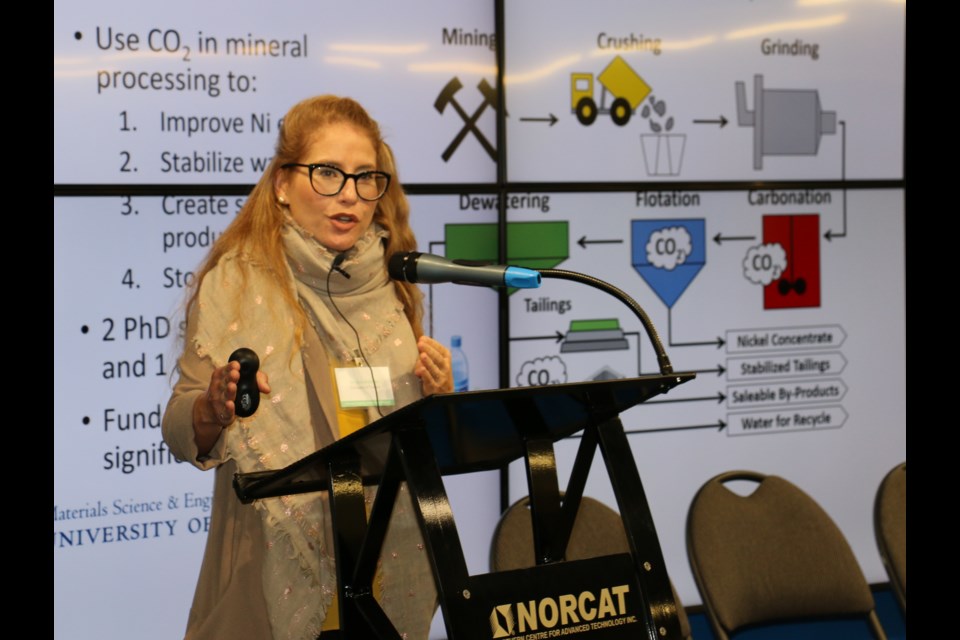A University of Toronto professor who began her environmental engineering career in Sudbury several years ago is currently working on a project to capture carbon from the atmosphere with nickel ore and mine tailings.
At the same time she is studying the idea of using microwave energy to weaken rocks in the ore grinding process, something that is expected to be a huge energy cost saver. It might lead to the construction of a demonstration plant in Sudbury.
Dr. Erin Bobicki is an assistant professor in the Department of Materials Science and Engineering at the U of T. She was a guest speaker at a recent Northern Ontario Innovation event sponsored by the Ontario Chamber of Commerce at the NORCAT Centre in Sudbury.
Bobicki was one of the finalists named in the 2019 Natural Resources Canada Crush-It Challenge to find cleaner and more energy efficient technology for ore crushing and grinding in the mining industry. She was also awarded $471,000 this year in a research partnership with Vale Canada to find ways to capture environmental carbon with mine tailings.
“Yes it has been known for a number of years actually that mine tailings, asbestos tailings, things with serpentine in them, any sort of alkaline rock material that can be waste, actually passively takes up CO2. So there are mining companies across the world that are monitoring this and using it to offset CO2 credits and things,” Bobicki said in an interview with Sudbury Mining Solutions Journal.
She said the tailings project is sponsored by Vale and is directed toward climate change mitigation.
“Asbestos tailings in Quebec, the piles are actually reacting with CO2 that is in the air and converting it to carbonate minerals. And carbonate minerals are very thermodynamically stable. It takes either a lot of heat or a lot of acid to release that CO2, so it a very stable form of carbon storage,” she said.
Bobicki said the idea is to create a carbon reaction with the nickel ore before sending in for the conventional processing. The process is called carbonating.
“So some of these ores that contain these minerals one of the main ones is called serpentine and it makes processing very difficult. It adheres to the valuable minerals and makes it difficult to recover them in floatation. It increases the viscosity of the slurries,” she explained.
“This new project is carbonating upstream to enhance nickel extraction, so that by converting that serpentine to carbonate minerals, and storing that CO2, we can actually enhance the extraction of nickel from the ore because we don’t have that serpentine anymore. We destroyed it in carbonation,” she continued.
As a follow to that Bobicki said the carbonate rocks are ideal for creating a value-added product for creating concrete cement. She said the cement could be used in solidifying backfill material in mines, along with the obvious construction uses in mines and mills as well as regular civil engineer projects.
If that wasn’t enough, Bobicki’s research is also working on ways to convert microwave energy into a cheaper and better way to process ore.
Bobicki said in conventional mining comminution – the process of tumbling, crushing and grinding – too much energy is lost. She said the cost of operating the grinding and crushing mills could make up 50 to 70 per cent of the cost of running a mine.
“It’s like one per cent of the energy actually goes into breaking the rocks. With microwaves you’re actually directing that energy exactly where you want breakage and you can do a couple of things. One is you do get breakage along grain boundaries because you get differential thermal expansion of different materials.
‘You weaken the ore. It takes less energy to actually grind it because you break it right along the grain boundaries, you don’t need to grind as fine. And it is in the find grinding machine where you use most of the energy,” she said.
The plan is to create a pilot plant in Vancouver, which will operate at the rate of 50 tonnes per hour. Bobicki said eventually the testing will need to study significantly larger volumes of rock.
“The challenge is now to prove this at scale so that the mining industry can use it in operations,” she said. Bobicki added that the research is being done with Glencore XPS. She said following her work at the pilot plant in Vancouver, her plan is to carry on more research with the creation of a demonstration plant at the Strathcona mill in Onaping.
- Sudbury.com
AN EXPANDED REPORT ON THIS STORY WILL BE FEATURED IN THE DECEMBER ISSUE OF THE SUDBURY MINING JOURNAL.
